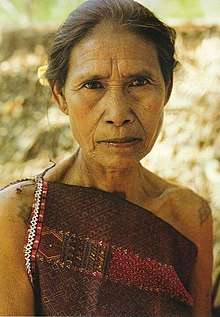Mro People
| မြိုလူမျိုး | |
|---|---|
 Mro Woman.jpg | |
| Total population | |
| 77,527- 83,000 (2004, est.) | |
| Regions with significant populations | |
| Myanmar (Chin State, Rakhine State) | |
| 83,000 | |
| Languages | |
| Mro (dialects: Arang (Ahraing Khami, Areung, Aroeng),Xengna (Hrengna, Xata, Vakung (Wakun, Wakung)) | |
| Religion | |
| Animism, Buddhism and Christianity | |
| Related ethnic groups | |
| Chin people | |
The Mro People (Burmese: မြိုလူမျိုး) are one of the 135 ethnic groups recognized by the government of Myanmar.They are identified as a sub-group of Chin people. Also known as Mro, Mro (Wakim), Awa Khami, Khami, Khumi Awa, Mro-Khimi, “Kwe Myi” in Myanmar.The live widely in some parts of northern Rakine state, Chin state, the townships of Matupi and Paletwa, and the regions of Samechaung and Michaung. They are Tibeto-Burman and have their own language, culture and customs which are still in existence.For Chin specifically, the Awa Khami are one of 53 sub-groups identified by the government of Myanmar.
Religion
Animism
The Mro People still believe animism as their custome, especially for their traditional festival. Merely 36.60%.
Buddhism
The Mro practise both animism and Buddhism. A strong Buddhist influence exists as about 55% of the population adhering to Theravada Buddhism, a common sect of Buddhism eminent throughout mainland Southeast Asia, especially in Myanmar (Burma) and Thailand.
Christianity
Merely 7.14% of the Mro adheres to Christianity. New Testament was translated into Mro language in 2017.
Language
They primarily speak the Mro language, Kuki-Chin language of Burma, Mro is spoken in the following townships of Myanmar (Ethnologue).
- Chin State: Paletwa township
- Rakhine State: Kyauktaw, Buthidaung, Ponnagyun, Pauktaw, Mrauk U, and Maungdaw townships.
There are 4 main dialects of Mro (Ethnologue).
- .Arang (Ahraing Khami, Areung, Aroeng)
- .Xengna (Hrengna)
- .Xata
- .Vakung (Wakun, Wakung).
Arang (Ahraing Khami, Areung, Aroeng), Xengna (Hrengna), Xata, Vakung (Wakun, Wakung). Generally high comprehension of Vakung dialect among other dialect speakers. Wakun (Vakung) is the most widely spoken and understood dialect (Horney 2009:5) and basis of literature. Lexical similarity: 91%–98% within Mro(Khimi) varieties, 86%–90% with Likhy variety of Eastern Khumi [cek], 81%–85% with Lemi variety of Eastern Khumi [cek], 77%–81% with Kaladan Khumi [cnk].
References
- Hornéy, Christina Scotte. 2012. A phonological analysis of Mro Khimi. MA thesis, University of North Dakota.